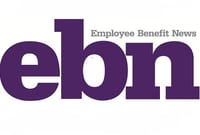 Much has been written in the media, including this column, about the increase in mobility of today’s American workforce.
Much has been written in the media, including this column, about the increase in mobility of today’s American workforce.
The Employee Benefit Research Institute (EBRI) estimates that the average American will change jobs 9.9 times during a 45-year working life—and according to EBRI research, about 14.8 million defined contribution plan participants switch employers every year. The U.S. Bureau of Labor Statistics also reports that monthly quit rates have doubled since the Great Recession.
While this isn’t a new development, what is surprising is the nature of the plan sponsors where these job-changers end up.
Newly compiled EBRI data indicates that the vast majority (82.98%) of these participants go to an employer with a plan equal in size, or larger than, their former employer’s plan. Furthermore, 62.73% of job-changing participants go from one employer with a large plan (defined as having more than 1,000 participants) to another.
Of the 16 sponsors with large plans included in EBRI’s sample for this analysis, 13 were providers of healthcare services.
In other words, most job-changing participants go to employers in the same industry with similar-sized plans, or larger plans.
Only 17.02% of participants who switch jobs every year go to employers with smaller plans, and a mere 1.9% leave employers with large plans to go to one with a small plan (defined as having less than 100 participants).
Easier Plan-to-Plan Portability Won’t Hurt Participants
This vital EBRI research demonstrates that, contrary to preconceptions, most job-changing participants do not go from less expensive plans to more expensive plans.
According to the 401(k) Averages Book, plans with 10 participants have an average expense ratio of 1.34%, and plan expenses go down as the number of participants goes up. Indeed, the 401(k) Averages Book reports that plans with 2,000 participants have an average expense ratio of 0.70%.
Some colleagues in the retirement services industry are concerned that measures to simplify plan-to-plan portability (including auto portability) could harm participants, because they would move and consolidate their savings into accounts in plans which are more expensive. While their concern is well-intentioned, EBRI’s analysis proves that it is unwarranted.
Furthermore, terminated-participant accounts still need to be serviced, even though the accountholders are no longer employed by the plan sponsor. As a result, too many small, stranded accounts can weigh down a plan’s infrastructure and increase expenses.
Auto portability—the routine, standardized, and automated movement of a retirement plan participant’s 401(k) savings account from their former employer’s plan to an active account in their current employer’s plan—has been live for more than two years. By giving sponsors the tools and technology they need to help participants roll their 401(k) account balances into accounts in their new-employer plans at the point of job-change, auto portability can enable sponsors to increase their plans’ average account balances.
A research study conducted by Deloitte Consulting on behalf of the Investment Company Institute uncovered a correlation between sponsors’ plan fees and average account balances—the median “all-in fee” (the combination of a sponsor’s recordkeeping, administrative, and investment management fees as a percentage of plan assets) was lower for plans with higher average account balances in 2013.
So, not only do most job-changing participants migrate to employers with large (and therefore, less expensive) plans, but account consolidation at the point of job-change actually helps both the employers they leave, and those they join, to reduce their plan fees.
In other words, roll-in transactions and the auto portability solution which enables them benefit everyone, and hurt no one.
- Home
- Individuals
- Auto Portability
- Plan Sponsors
- The Small Account Problem
- RCH Portability Services
- Plan Sponsor Support
- The Missing Participant Problem
- What is a Missing Participant?
- Why Plan Sponsors Should be Concerned
- What Causes Missing Participants?
- The Magnitude of the Problem
- What Regulations Apply to Missing Participants?
- Sources of Uncertainty for Plan Sponsors
- Best Practices for Finding Missing Participants
- What to Look For in a Search Service
- Learn More About Missing Participants
- RCH's Missing Participant Search Service
- Terminating 401(k) Plans
- Participant Testimonials
- Due Diligence Material
- Contact Us
- Accountholders
- Company
- News & Information
- Login
